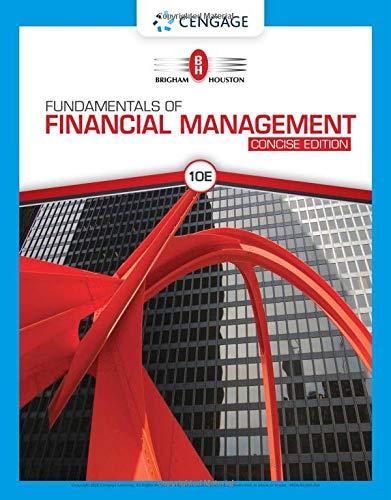
a
Introduction: Translation adjustment is the method used to convert the local currency into the parents’ functional currency when the local currency is the foreign entity’s functional currency. The current rate is used to translate the financial statements that are the exchange rate on the
The strengthening or weakening of currency in 20X6 and 20X7 by presenting both direct and indirect exchange rate for the rupees for the given dates.
a
Answer to Problem 12.13E
The dollar strengthened both during 20X6 and 20X7
Explanation of Solution
| Direct $/R 1 | Indirect R/$1 | |
| January 1, 20X6 | $.03333 = R 1 | R 30 = $1 |
| December 31, 20X6 | $.02857 = R 1 | R 35 = $1 |
| December 31, 20X7 | $.025 = R 1 | R40 = $1 |
The dollar appreciated against rupees during 20X6 because the amount of rupees required to buy one U.S dollar at the end of the year is R35 which is greater than the amount of rupees required to buy one dollar at the beginning of the year that is R 30. The dollar value continued its upward trend during the year 20X7 to R40.
b
Introduction: Translation adjustment is the method used to convert the local currency into the parents' functional currency when the local currency is the foreign entity’s functional currency. The current rate is used to translate the financial statements that are the exchange rate on the balance sheet date. The average rate is used to translate revenue and expenses as it is assumed that occurs uniformly over the period. Any gain or loss on account of translation adjustment is recognized in the comprehensive income statement.
The subsidiary’s translated balance sheet of December 31, 20X6 assuming rupee is the subsidiary’s functional currency.
b
Answer to Problem 12.13E
The dollar strengthened both during 20X6 and 20X7
Explanation of Solution
Translated balance sheet for December 31, 20X6
| Details | Subsidiary balancesIn Rupees | Direct exchange rate | Translated balances$ |
| Cash | 100,000 | $.02857 | $2,857 |
| Receivables | 450,000 | $.02857 | 12,857 |
| Inventory | 680,000 | $.02857 | 19,428 |
| Fixed assets | 1,000,000 | $.02857 | 28,570 |
| Total assets | 2,230,000 | 63,712 | |
| Accumulated other comprehensive income: | |||
| Translation adjustment debit | 2,903 | ||
| Total Assets | 66,615 | ||
| Current payables | 260,000 | $.02857 | 7,428 |
| Long term debts | 1,250,000 | $.02857 | 35,713 |
| Common stock | 500,000 | $.03333 | 16,665 |
| 220,000 | $03095 | 6,809 | |
| Total Liabilities and Equity | 2,230,000 | 66,615 |
Exchange rate for retained earnings will be average of beginning and ending exchange rate
Working note: Proof of translation adjustment
| Details | In Rupees | translation rate | $ |
| Net assets 1/1/X6 | 500,000 | $.03333 | 16,665 |
| Adjustment for changes in net assets during year | |||
| Net income | 220,000 | $.03095 | 6,809 |
| Net assets translated at: | |||
| Rates during the year | 23,474 | ||
| Rates at end of the year | 720,000 | $.02857 | (20,570) |
| Change in translation adjustment during year | 2,904 |
c
Introduction: Translation adjustment is the method used to convert the local currency into the parents' functional currency when the local currency is the foreign entity’s functional currency. The current rate is used to translate the financial statements that are the exchange rate on the balance sheet date. The average rate is used to translate revenue and expenses as it is assumed that occurs uniformly over the period. Any gain or loss on account of translation adjustment is recognized in the comprehensive income statement.
The subsidiary translated balance sheet as of December 31, 20X7 assuming the rupee is the subsidiary functional currency
c
Answer to Problem 12.13E
Balance sheet total after translation adjustment $61,885
Explanation of Solution
| Details | Subsidiary balancesIn Rupees | Direct exchange rate | Translated balances$ |
| Cash | 80,000 | $.025 | $2,000 |
| Receivables | 550,000 | $.025 | 13,750 |
| Inventory | 720,000 | $.025 | 18,000 |
| Fixed assets | 900,000 | $.025 | 22,500 |
| Total assets | 2,250,000 | 56,250 | |
| Accumulated other comprehensive income: | |||
| Translation adjustment debit | 5,635 | ||
| Total Assets | 61,885 | ||
| Current payables | 340,000 | $.025 | 8,500 |
| Long term debts | 1,100,000 | $.025 | 27,500 |
| Common stock | 500,000 | $.03333 | 16,665 |
| Retained earnings | 310,000 | A | 6,809 |
| Total Liabilities and Equity | 2,250,000 | 61,885 |
Determination of retained earnings
| Retained earnings December 31, 20X6 | $6,809 |
| 2,411 | |
| $9,220 |
Working note: Proof of translation adjustment
| Details | In Rupees | translation rate | $ |
| Net assets 1/1/X6 | 720,000 | $.02857 | 20,570 |
| Adjustment for changes in net assets during year | |||
| Net income | 90,000 | $.02679 | 2,411 |
| Net assets translated at: | |||
| Rates during the year | 22,981 | ||
| Rates at end of the year | 810,000 | $.025 | (20,250) |
| Income translation | 2,731 | ||
| Translation adjustment 1/1/X7 | 2,904 | ||
| Accumulated other comprehensive | |||
| Translation adjustment 12.31.X7 | 5,635 |
d
Introduction: Translation adjustment is the method used to convert the local currency into the parents' functional currency when the local currency is the foreign entity’s functional currency. The current rate is used to translate the financial statements that are the exchange rate on the balance sheet date. The average rate is used to translate revenue and expenses as it is assumed that occurs uniformly over the period. Any gain or loss on account of translation adjustment is recognized in the comprehensive income statement.
The comprehensive income for 20X7 would include as a result of the translation
d
Answer to Problem 12.13E
The comprehensive income for 20X7 would include as a result of the translation $2,731
Explanation of Solution
Income to be reported in 20X7
| Details | In Rupees | translation rate | $ |
| Net assets 1/1/X6 | 720,000 | $.02857 | 20,570 |
| Adjustment for changes in net assets during year | |||
| Net income | 90,000 | $.02679 | 2,411 |
| Net assets translated at: | |||
| Rates during the year | 22,981 | ||
| Rates at end of the year | 810,000 | $.025 | (20,250) |
| Income translation | 2,731 |
Want to see more full solutions like this?
Chapter 12 Solutions
ADVANCED FINANCIAL ACCT.(LL) >CUSTOM<
- The ending inventory for the year would bearrow_forwardThe ending inventory for the year would be valued at?arrow_forwardA company has a market value equal to its book value. Currently, the company holds excess cash of $18,000, other assets of $22,000, and total equity of $30,000. The company has 2,000 shares of stock outstanding and a net income of $3,600. The company decides to spend 40% of its excess cash on a share repurchase program. How many shares will remain outstanding after the stock repurchase is completed?arrow_forward
- I want to this question answer for General accounting question not need ai solutionarrow_forwardProvide answerarrow_forwardEverton Production forecasts that total overhead for the current year will be $8,400,000 and that total machine hours will be 180,000 hours. Year to date, the actual overhead is $9,100,000, and the actual machine hours are 195,000 hours. Suppose Everton Production uses a predetermined overhead rate based on machine hours for applying overhead as of this point in time (year to date). In that case, what is the amount of overapplied or underapplied overhead?arrow_forward
- explain properly all the answer for General accounting question Please given fastarrow_forwardDave Manufacturing Company's manufacturing overhead is 65% of its total conversion costs. If direct labor is $52,000 and direct materials are $36,000, what is the manufacturing overhead?arrow_forwardYoung Industries' unadjusted COGS for 2022 was $118,500. They had a $12,400 unfavorable direct labor efficiency variance, a $5,600 favorable direct labor rate variance, a $8,300 unfavorable direct materials purchase price variance, and a $4,200 favorable direct materials usage variance. They did not have any overhead variances. What was Young Industries' adjusted COGS amount for 2022?arrow_forward
 Financial Reporting, Financial Statement Analysis...FinanceISBN:9781285190907Author:James M. Wahlen, Stephen P. Baginski, Mark BradshawPublisher:Cengage Learning
Financial Reporting, Financial Statement Analysis...FinanceISBN:9781285190907Author:James M. Wahlen, Stephen P. Baginski, Mark BradshawPublisher:Cengage Learning Fundamentals Of Financial Management, Concise Edi...FinanceISBN:9781337902571Author:Eugene F. Brigham, Joel F. HoustonPublisher:Cengage Learning
Fundamentals Of Financial Management, Concise Edi...FinanceISBN:9781337902571Author:Eugene F. Brigham, Joel F. HoustonPublisher:Cengage Learning




